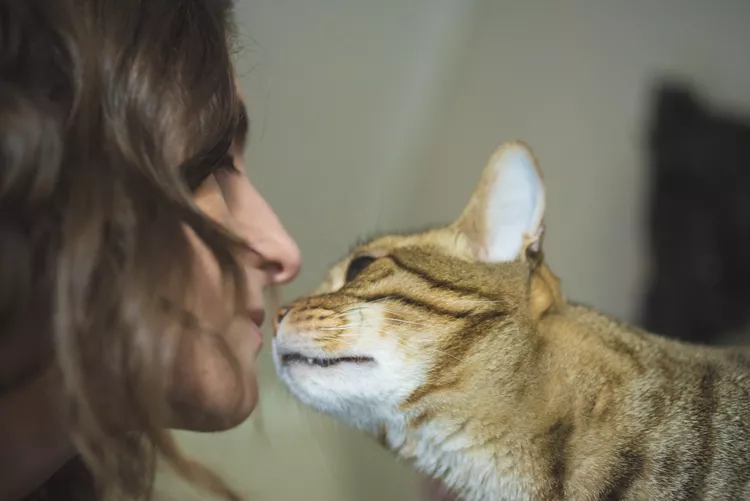What Is the Flehmen Response in Cats?

Does your cat sometimes make a weird sneering face? Cats lift their lips after a particularly long sniff and hold the mouth slightly open to sniff cat pheromones. Flehmen—a German word that means "lip curl"—might be mistaken for an aggressive snarl but is a perfectly normal and peaceful cat behavior.
Pheromones
Cats use pheromones, or scent hormones, to communicate with other cats. Each animal has its own unique pheromones, which can signal different messages to other cats. For instance, a cat may rub its cheek against an object and release pheromones to mark its territory and pheromones in cats' urine signal their gender.
A cat grimaces when its tongue traps pheromones, then flick-transfers the pheromones to the duct in the roof of its mouth. That's when the so-called flehmen response occurs: The cat curls the upper part of its mouth in what appears to be a sneer. All cats use this second sniff-mechanism to analyze pheromones but male cats show the flehmen kitty sneer most often. That may be because they are particularly attuned to checking out sex-related information even if they are neutered.
Cat's will also mark their favorite humans with pheromones as well. A headbutt or cheek rub from a cat is its way of saying "this human is mine." It's a sign of true affection from your feline companion.
Jacobson's Organs
Jacobson's organs, or vomeronasal organs, are found between the hard palate of the mouth and the septum of the nose. Tiny ducts connect them to openings behind cats' teeth in the roof of the mouth. Jacobson's organs ultimately link to the hypothalamus in the brain and can affect social and sexual behavior.
Jacobson's organ is named for Ludvig Levin Jacobson, the Danish physician who discovered it in 1811. Cats are not the only animals with Jacobson's organs. Strangely enough, even humans have them. According to Dr. Anne Marie Helmenstein, while humans don't display the Flehmen reaction, recent studies have demonstrated that Jacobson's organ functions as in other mammals to detect pheromones and to sample low concentrations of certain non-human chemicals in the air. There are indications that Jacobson's organ may be stimulated in pregnant women, perhaps partially accounting for an improved sense of smell during pregnancy and possibly implicated in morning sickness.
Probably the most well-known animal with a Jacobson's organ other than cats is the common snake, which, of course, is a reptile.
Flehmen's Response
There are a wide variety of animals that show flehmen's response to various scents. Cats and horses are the best-known, but giraffes and elephants frequently show this behavior as well. Buffalo, goats, llamas, rhinoceros, pandas, and hippos also have been observed showing flehmen's response to a scent, usually another animal of their species.